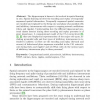Free Online Productivity Tools
i2Speak
i2Symbol
i2OCR
iTex2Img
iWeb2Print
iWeb2Shot
i2Type
iPdf2Split
iPdf2Merge
i2Bopomofo
i2Arabic
i2Style
i2Image
i2PDF
iLatex2Rtf
Sci2ools
119
Voted
ICANN
2010
Springer
2010
Springer
Dynamics and Function of a CA1 Model of the Hippocampus during Theta and Ripples
The hippocampus is known to be involved in spatial learning in rats. Spatial learning involves the encoding and replay of temporally sequenced spatial information. Temporally sequenced spatial memories are encoded and replayed by the firing rate and phase of pyramidal cells and inhibitory interneurons with respect to ongoing network oscillations (theta and ripples). Understanding how the different hippocampal neuronal classes interact during these encoding and replay processes is of great importance. A computational model of the CA1 microcircuit [3], [4], [5] that uses biophysical representations of the major cell types, including pyramidal cells and four types of inhibitory interneurons is extended to address: (1) How are the encoding and replay (forward and reverse) of behavioural place sequences controlled in the CA1 microcircuit during theta and ripples? and (2) What roles do the various types of inhibitory interneurons play in these processes?
| Added | 11 Feb 2011 |
| Updated | 11 Feb 2011 |
| Type | Journal |
| Year | 2010 |
| Where | ICANN |
| Authors | Vassilis Cutsuridis, Michael E. Hasselmo |
Comments (0)

